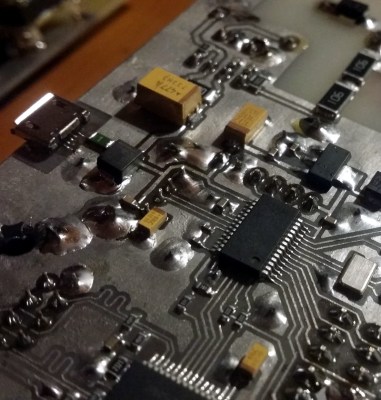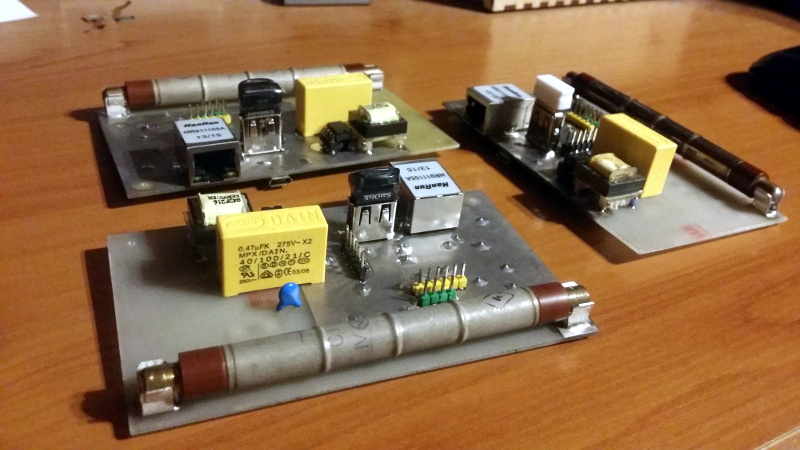It started as a joke, as sometimes these things do. [Marek Więcek] thought building a personal radiation detector would not only give him something to work on, but it would be like having a gadget out of the Fallout games. He would check the data from time to time and have a bit of a laugh. But then things got real. When he started seeing rumors on social media that a nearby nuclear reactor had suffered some kind of radiation leak, his “joke” radiation detector suddenly became serious business.
 With the realization that having his own source of detailed environmental data might not be such a bad idea after all, [Marek] has developed a more refined version of his original detector (Google Translate). This small device includes a Geiger counter as well as sensors for more mundane data points such as temperature and barometric pressure. Since it’s intended to be a stationary monitoring device, he even designed it to be directly plugged into an Ethernet network so that it can be polled over TCP/IP.
With the realization that having his own source of detailed environmental data might not be such a bad idea after all, [Marek] has developed a more refined version of his original detector (Google Translate). This small device includes a Geiger counter as well as sensors for more mundane data points such as temperature and barometric pressure. Since it’s intended to be a stationary monitoring device, he even designed it to be directly plugged into an Ethernet network so that it can be polled over TCP/IP.
[Marek] based the design around a Soviet-era STS-5 Geiger tube, and outfitted his board with the high voltage electronics to provide it with the required 400 volts. Temperature, barometric pressure, and humidity are read with the popular Bosch BME280 sensor. If there’s no Ethernet network available, data from the sensors can be stored on either the built-in SPI flash chip or a standard USB flash drive.
The monitor is powered by a PIC32MX270F256B microcontroller with an Ethernet interface provided by the ENC28J60 chip. In practice, [Marek] has a central Raspberry Pi that’s polling the monitors over the network and collecting their data and putting it into a web-based dashboard. He’s happy with this setup, but mentions he has plans to add an LCD display to the board so the values can be read directly off of the device. He also says that a future version might add WiFi for easier deployment in remote areas.
Over the years we’ve seen a fair number of radiation monitors, from solar-powered WiFi-connected units to the incredible work [Radu Motisan] has done building his global network of radiation detectors. It seems hackers would rather not take somebody else’s word for it when it comes to the dangers of radiation.















A network connected sensor without an ESP8266/ESP32! You don’t see that much nowadays.
It’s nice to see people using the PIC32 chips, they are neat.
I think it’s because he wanted it wired instead of wireless, but then why no PoE support?
Nice! Btw, LCD display should be LC-display or just LCD, since D is short for display. When I skimmed the title I read A Network Attached Radiator Monitor, for monitoring the radiator of central heating :)
What about LED Diodes ? :)
Can these geiger tubes can detect low enough levels? I mean, are they useful outside of a nuclear disaster zone, as a kind of personal dosimeter for lower levels of radiation like this case?
I’m pretty sure it can detect background radiation. The concern is the energy and radiation source.
yes, the normal background radiation is about 20 counts per minute with such tubes. https://www.pocketmagic.net/tube-sts-5-%D1%81tc-5-geiger-tube/
They can, but they aren’t hugely sensitive. The main drawback of Geiger tubes is that they can’t distinguish different types of radiation, they’re really only good for distinguish between “everything’s fine”, “hmm that’s not good” and “oh shit”, without much resolution in between.
There’s been a lot of research in compact scintillators, which tell you a lot more info, but they are still a little too expensive for most citizen scientists (as well as being somewhat more delicate and harder to operate). Which is unfortunate, the data we got out of it would be really valuable scientifically.
Well he did say he stepped up his game when he heard rumours that a nuclear plant in his area was leaking radiation, so for that purpose a scale from “everything’s fine” to “oh shit” is probably good enough.
They can, but the main problem is that Geiger counters can’t distinguish between different types of resolution. Tubes this small aren’t super sensitive, either. Combined, this means that this type of detector is only really useful for distinguishing between “everything’s fine”, “hmm that’s weird”, and “oh shit”, without much resolution in between.
There’s been some companies and research trying to reduce the cost of more sophisticated detectors, but they’re still a bit too expensive for citizen science. Which is unfortunate, the data we could collect would be very scientifically valuable.
These tube at kind of crappy. But they are cheap!
You can get some nice pancake or other mica windowed rubes from russia too but they are significantly more expensive. I think around $100 average.
Once I played for a while with a Belarusian cold war radiation detector. Likely it was based on the same tube. The only thing that produced increased “tick rate”, distinguishable from background was Polish mineral water “Staropolanka”.
Sounds kind of like me uncle. He got a meter and spent days just running around testing everything with it, one of the only thing he found that really caused a largish spike above background was a partial pallet of tar roofing tiles we had out behind the house after getting the roof repaired.
Try using low sodium salt (high in potassium) and that should be about times higher than normal background levels (depending on where you are in the world)
About how many times?
Yes,
“about” times higher.
I’m not familiar with the About scale, but, I think it needs to be referenced to something to be meaningful, sort of like deciBels, someone can say 10 deciBels but it doesn’t tell you the reference like 10 dBm does.
3, I must have hit the delete key by accident.
I am always surprised to see those project with “soviet era” tubes, as they are known for having a short life https://apps.dtic.mil/dtic/tr/fulltext/u2/746267.pdf
At my local hackerspace (RevSpace) we built something similar to this using an ESP8266 attached to a pre-built Geiger counter board. It outputs the count-per-minute over WiFi to an MQTT server. Graphs are made using Grafana, but the result is a bit boring, we don’t see much fluctuation. Code is on github, see https://revspace.nl/Geigercounter
Geiger counters use cascade amplification in their detection scheme. If you really want to get an idea of dose you want to use an ionization chamber. Way more fun.
https://en.wikipedia.org/wiki/Ionization_chamber
Now build a version that will survive the radiation it is being exposed to.
STS-5 is not designed to measure high radiation levels. If fact it was developed to monitor radiation ranging near to typical background level. During the cold war there were even used in Polish radiation monitors, manufactured for civilians. No scale for detailed information – just a buzzer and light-bulb telling you, that there is something wrong.
Slight (but noticeable) raise in background radiation level, caused by the nuclear reactor catastrophe in one of the neighboring countries doesn’t kill the electronics. In case of global thermonuclear war I think there will be much more urgent issues to deal with than fried electronic device…
Green hack perpetuates a misnomer that radiation is not of nature. I.e milk, beer and effin Radon! Science hack would have been way cooler tag. Great prpgext. Will help me monitor all the natural occurring radon which seeps out of the bedrock beneath my home
Well my sensor has been working for maybe 3 years. Incidentally if anyone knows why a couple of the ones in France stopped transmitting (29th June 2018) please let me know. I would be intrigued. Unit 1200004B comes to mind.